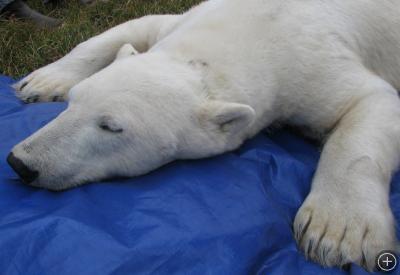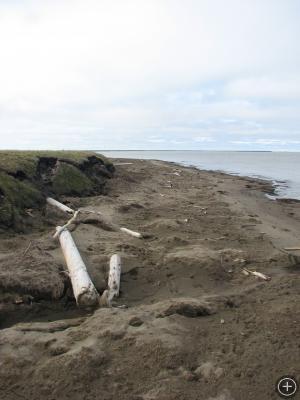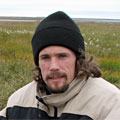Luck – and Snow – in the Air
LARAMIE, WYOMING– After several days of poor weather made flying impossible, we finally had a morning with fair visibility and light winds, allowing us to fly for polar bear captures. We finalized all of the daily preparation of gear, such as loading firearms and filling up our sample-transfer tank with liquid nitrogen. We placed all of the gear into a truck and drove over to the helicopters, then loaded the helicopters. Most folks were already in the helicopter and I was about to step in and put on my flight helmet, when someone said “Say, look over at the drill rig!” There was a drilling rig for oil about a half mile down the coast, with a tower perhaps two hundred feet tall. The very top of the tower was starting to disappear into a fog. After waiting for clear weather, I couldn’t believe our morning was going to be stalled by fog – but sure enough, the top disappeared, then the bulk of the tower, and in the space of about two minutes, visibility dropped from several miles to about 100 meters. We were grounded again for a day.
Thankfully, that fog cleared soon and we got back to captures. We had great luck the first day out, capturing our first bear by 9am. It was a small bear and we all thought it was recently-weaned, making it about 32 months old. However, when we checked its marks we discovered it was a five-year old female, making it an adult. She was in decent shape but she was short and did not have lots of fat. Unlike a lot of bears we capture in summer her fur was clean and mostly free of mud.

We captured this adult female last week. Because she was not very fat, her limbs appeared longer and thinner than other bears we have captured. She is laying on a blue tarp on the tundra.
That afternoon we caught another bear immediately after we finished working on the first bear. The warm weather from early August had disappeared, and temperatures were much colder. We set up the windbreak to make our sampling easier, and shortly thereafter it began to snow lightly. I was really excited – I had not yet seen snow in August. We finished up that bear and began to fly home, only to have the other helicopter spot an adult male bear. It was a bear we had not captured yet and it was on a large island that would make darting possible. While they began the capture, we flew back to Oliktok to grab some additional supplies before joining the other helicopter.
I had not done a full sampling on a large adult male, so it was a different and fascinating experience to do everything on a 950 lb bear. We did not wrap up until late at night, and when we returned we did not finish our lab work until 2am. It was a great day, increasing our total captures by 3 all at once.

The cool weather and low clouds stuck around for the next several days. Here, we landed our helicopter next to this beach during a break from looking for bears. The tundra at the left is slowly being eroded into the beach.

We flew over this area one afternoon. Our pilot suggested that this was the remnants of a fenced pasture built with driftwood. Some folks – perhaps those of the local indigenous culture – may have used it to keep caribou.
We extended our stay at Oliktok by several days in an attempt to catch just one or two more bears. We caught one more bear, an adult female in excellent shape with lots of fat; she was very large for a female, weighing 770 lbs. She had no young and was most likely pregnant. If pregnant, she will likely dig a den into a snowbank by October or November, and begin hibernating. She will give birth in December or January while hibernating, then she and her young will emerge in the spring to head out onto the sea ice and hunt seals.
On last Thursday afternoon, I drove the two hours from Oliktok back to Deadhorse and returned the truck. I caught the afternoon flight to Barrow, then Anchorage, then Seattle. I slept on a bench in the Seattle airport for several hours, then I caught a flight to Minnesota to visit family, where it was 90 degrees (Fahrenheit) and humid – quite a change from the north slope. I had the opportunity to give a public talk in Minnesota, with an audience of over 50 interested friends and family.
We now have a short break between field seasons. I have sent a complete set of field gear to Seattle, where it is being loaded onto a US Coast Guard icebreaker, the Polar Sea. This ship will leave port in late August, eventually making it offshore from Barrow in northern Alaska. In late September, we will use helicopters to get onto the ship from shore, and we will begin traveling north to get to the edge of the retreating sea ice. Once we make it to the ice we will spend the month of October recapturing bears that have spent the summer on the sea ice. Simultaneously, a second crew will return to Deadhorse and recapture bears that have spent the summer on shore.










When you capture the bears, what do you do to them? Thx
Hi Terry,
Thanks for reading the dispatch. We gather lots of data at each capture. Much of our sampling is based on previous work on black bears and brown bears, but which has not yet been applied to polar bears. First, we use tape measures to collect physical measurements such as length, chest girth, neck girth, and skull measurements. We weigh the bear, and collect a fur sample. Using a syringe we collect a blood sample, similar to how a sample is collected from a person during a visit to a doctor. Some of these measurements are described here (http://icestories.exploratorium.edu/dispatches/on-the-edge-of-the-arctic-national-wildlife-refuge/).
We employ a technique called Bioelectrical Impedance Analysis (BIA) to measure body fat content, described here (http://icestories.exploratorium.edu/dispatches/how-fat-is-a-polar-bear/). Similar to deluxe bathroom scales this technique measures the bear’s resistance to a harmless electrical current, then converts the resistance to percent body fat.
We collect a breath sample by having the bear breathe through a mask into a bag, described here (http://icestories.exploratorium.edu/dispatches/getting-by-without-food/). We analyze the breath to establish whether the bear is eating or burning internal stores for energy, and whether the main food source consists of protein, fat, or carbohydrates.
Using a sterile approach (sterile tools and gloves) we collect a small sample of fat and muscle from the bear’s leg. These samples are analyzed to find out if the bear is eating or fasting, the condition of its fat stores, and whether the bear has reduced its activity to reduce its energetic needs. We also implant a tiny data logger beneath the skin to record body temperature. It has been hypothesized that polar bears reduce their body temperature and metabolic rate in summer to reduce their energetic needs, but such measurements have not been recorded.
Finally, some bears are fitted with a radio collar. If we recapture the animal we remove the collar; if we don’t recapture the animal, the collar has an automatic release device programmed to cause the collar to fall off after a certain time period.
Thanks,
John
Hi John…fun to follow what you are up to. Sorry to have missed you and your talk at the folk’s house, but we had family goings-on here! Your work is fascinating, hope to see you at Christmas! Carol & Gene
Hello John! I have so enjoyed reading your entries. I am starting to teach here at Minnewashta this week and am teaching my class about stamina with reading. As I was trying to teach them what stamina means I thought about the swimming polar bears do and how you have shared that. I hope you are ok that we show our students some of your pictures as we explain our concept. What a fun way to do it! Hope all is well. I have learned so much from your information. Sorry to have missed your presentation. We had headed up north to Pete’s cabin for the weekend. Hope to catch you next time you are home.
Love and miss you! Niki
Hi Niki,
Certainly – I am very glad that this study and the pictures were useful for your class. I hope the students enjoyed learning a bit about polar bears. Sorry I missed you guys as well.
I am in Denver this evening, and will be flying all day tomorrow to arrive in Barrow in the evening. Have a good start to autumn!
John